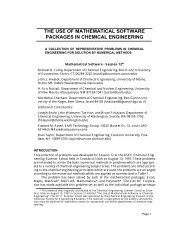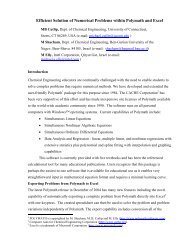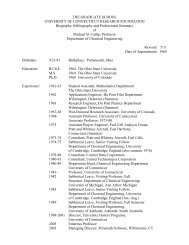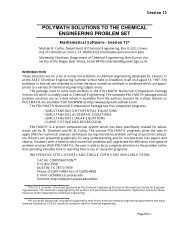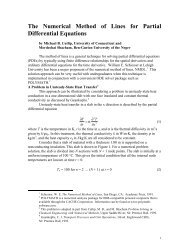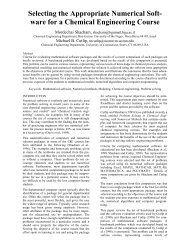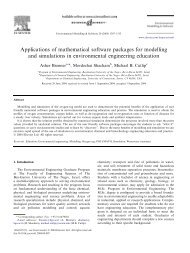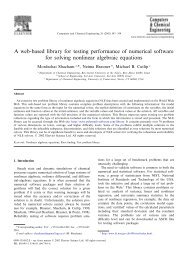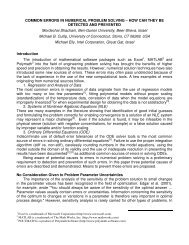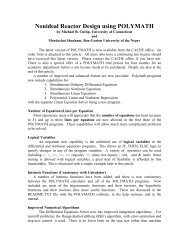Maple Solutions to the Chemical Engineering Problem Set
Maple Solutions to the Chemical Engineering Problem Set
Maple Solutions to the Chemical Engineering Problem Set
Create successful ePaper yourself
Turn your PDF publications into a flip-book with our unique Google optimized e-Paper software.
f(re);<br />
C ( re )<br />
D<br />
The next step is <strong>to</strong> create a <strong>Maple</strong> procedure <strong>to</strong> evaluate <strong>the</strong> force balance for different values of <strong>the</strong><br />
terminal velocity. There are many ways <strong>to</strong> do this; our example follows:<br />
> eqn := proc(vt)<br />
local C, re;<br />
global params;<br />
re:= subs(params,D[p]*vt*rho/mu);<br />
C[D]:=f(re);<br />
subs(params,vt-sqrt(4*g*(rho[p]-rho)*D[p]/(3*C[D]*rho)));<br />
end:<br />
Finally, we invoke <strong>Maple</strong>'s built in floating point solver<br />
> vt1:=fsolve('eqn'(vt),vt=0.00001..0.05);<br />
vt1 := .01578618582<br />
This is <strong>the</strong> terminal velocity of <strong>the</strong> particle under <strong>the</strong> given conditions. Note that eqn in <strong>the</strong> call <strong>to</strong><br />
fsolve is contained within quote marks. If this were not done <strong>the</strong>n <strong>Maple</strong> would attempt <strong>to</strong> call <strong>the</strong> eqn<br />
procedure and pass that result <strong>to</strong> fsolve. Needless <strong>to</strong> say, that would be a disaster in this case. <strong>the</strong> quote<br />
marks force <strong>Maple</strong> <strong>to</strong> re-evaluate <strong>the</strong> equation every time it tries a new value of <strong>the</strong> terminal velocity.<br />
The units here are m/s. The Reynolds number at this velocity is<br />
> subs(v[t]=vt1,params,reeqn);<br />
re = 3.656696458<br />
and <strong>the</strong> drag coefficient is<br />
> f(rhs("));<br />
8.840561062<br />
For part (b) we are asked for <strong>the</strong> terminal velocity in a centifugal separa<strong>to</strong>r where <strong>the</strong> acceleration is<br />
30 g. The only changes needed are <strong>to</strong> revise <strong>the</strong> set of parameters (in this case only g is changed).<br />
> params := {g=9.81*30,rho[p]=1800, D[p]=0.208e-3,rho=994.6,mu=8.931e-4};<br />
params := { g = 294.30 , ρ = 994.6 , μ = .0008931 , D = .000208 ,<br />
ρ = 1800}<br />
p<br />
p<br />
> eqn := proc(vt)<br />
local C, re;<br />
global params;<br />
params := {g=9.81*30,rho[p]=1800, D[p]=0.208e-3,rho=994.6,mu=8.931e-4};<br />
re:= subs(params,D[p]*vt*rho/mu);<br />
C[D]:=f(re);<br />
subs(params,vt-sqrt(4*g*(rho[p]-rho)*D[p]/(3*C[D]*rho)));<br />
end:<br />
Again we call fsolve<br />
> vt2:=fsolve('eqn'(vt),vt);<br />
vt2 := .2060692237<br />
The units here are m/s. The Reynolds number at this velocity is<br />
> subs(v[t]=vt2,params,reeqn);<br />
re = 47.73367101<br />
and <strong>the</strong> drag coefficient is<br />
> f(rhs("));<br />
1.556428713<br />
Page 26



